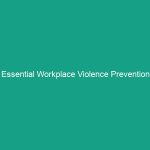Good Morning Team!
Today, we’re diving into an important topic that directly impacts our daily operations: Essential Verbal Communication and Workplace Safety Guidelines You Need. Effective communication is not just a skill; it’s a vital component of Workplace Safety that can prevent accidents and foster a culture of Safety.
Understanding Essential Verbal Communication and Workplace Safety Guidelines
Verbal communication in the workplace encompasses the spoken words we use to convey information, instructions, and Safety protocols. It plays a critical role in ensuring everyone is on the same page, particularly when it comes to safety. Miscommunication can lead to misunderstandings, which may result in accidents or injuries.
Many employees may think that verbal communication is merely about talking; however, it also involves listening, interpreting, and responding effectively. Understanding the nuances of verbal communication can enhance our ability to work safely and efficiently.
Key Hazards, Risks, and Safety Considerations
Neglecting effective verbal communication can lead to several Hazards:
- Misunderstandings: Instructions that are not clearly conveyed can lead to improper task execution.
- Information Overload: Too much information at once can confuse employees, leading to mistakes.
- Lack of Feedback: Not encouraging dialogue can prevent potential safety issues from being addressed.
Real-world consequences of ignoring these safety protocols can be severe, ranging from minor accidents to serious injuries. For instance, a construction site where directions are miscommunicated can lead to falls or equipment mishaps.
Best Practices, Procedures, & Actionable Advice
To improve verbal communication and Workplace Safety, consider these Best Practices:
1. Use Clear and Concise Language
Always opt for simple language when giving instructions. Avoid jargon unless everyone understands it. For example, instead of saying, “Ensure the equipment is calibrated,” say, “Check that the machine settings are correct.”
2. Encourage Questions and Feedback
Foster an Environment where employees feel comfortable asking questions. If someone doesn’t understand a safety procedure, they should be encouraged to speak up. This can be achieved through:
- Regular safety meetings.
- Anonymous feedback forms.
- Open-door policies with supervisors.
3. Confirm Understanding
After giving instructions, ask employees to repeat back what they understood. This technique, known as “active listening,” helps to ensure that everyone is on the same page. For example, after providing safety instructions, ask, “Can someone summarize what we just discussed?”
4. Use Non-Verbal Communication
Remember that non-verbal cues, such as gestures and body language, can significantly enhance verbal communication. Demonstrating tasks can help reinforce verbal instructions. For instance, showing how to wear Personal Protective Equipment (PPE) can make a lasting impression.
5. Share Real-World Examples
Case studies can be powerful teaching tools. Share stories of past incidents where miscommunication led to safety breaches and discuss how clear communication could have prevented those issues.
Regulations, Standards, and Compliance
Adhering to established safety Regulations is critical. OSHA (Occupational Safety and Health Administration) provides guidelines that emphasize the importance of effective communication in maintaining Workplace Safety. Compliance with these Standards not only protects employees but also shields the organization from legal repercussions.
Regular Training sessions should be conducted to ensure that all employees are aware of these regulations and understand the significance of following them. Remember, safety isn’t just a set of rules; it’s a shared responsibility.
Employee Engagement & Discussion
Now, let’s open the floor for discussion. Here are some questions to consider:
- What challenges have you faced with communication on the job?
- Can you share an experience where effective communication led to a safer work environment?
- How can we improve our communication practices to enhance safety?
Your thoughts and insights are invaluable in creating a safer workplace for everyone.
Conclusion & Key Takeaways
In conclusion, effective verbal communication is a cornerstone of Workplace Safety. By implementing the practices we discussed today, we can significantly reduce risks and enhance our work environment. Remember to:
- Communicate clearly and concisely.
- Encourage open dialogue and questions.
- Confirm understanding through active listening.
- Utilize non-verbal cues to reinforce messages.
- Learn from past incidents to improve future safety.
Thank you for your attention and commitment to safety. Let’s prioritize communication to ensure that we all return home safely at the end of each day!


